Study on Multi-Mode Switching Control of Intelligent Suspension under Full Road Section
Abstract
1. Introduction
2. Establishment of an Intelligent Suspension Model
2.1. Establishment of the Random Road Input Model
2.2. Establishment of 2-DOF 1/4 Vehicle System Dynamics Model
3. Establishment of a Model for Road Grade Estimation Based on Sensors
3.1. Establishment of the Sensor Data Acquisition Model
3.2. Establishment of the Road Identification Model
3.2.1. Adaptive Kalman Filtering Algorithm
- (1)
- The first step is to use the system state of the previous moment to estimate the system state of the present moment:
- (2)
- According to the system error covariance at the previous moment and the process noise variance at the moment, the error covariance at this moment is predicted:where is the error covariance matrix of the system update at ; is the prediction of the error covariance matrix at the time based on the system state at the time of the .
- (3)
- The measurement equation is introduced, and the estimated value of time obtained by Equation (18) is corrected to obtain:where is the difference between the observed value and the predicted value of the filtering state, that is, the measurement margin; is the Kalman gain coefficient at the time.
- (4)
- The error covariance matrix is modified to estimate the system state at the time . The expression is:where is the unit diagonal matrix with the same dimension as the suspension state.
3.3. Example Analysis of the Road Identification Model
4. Working Mode Switching Strategy Design
4.1. The Working Mode and Workflow of the Suspension System
- (1)
- Comfort working mode
- (2)
- Security working mode
- (3)
- Comprehensive working mode
- (4)
- Energy feedback working mode
4.2. Single-Double Threshold Sequential Judgment Switching Method
- (1)
- When , the actual value of the tire dynamic displacement is less than the set threshold and the actual value of the body acceleration is less than the threshold, it is judged that the vehicle is driving on the A-grade road surface. At this time, the tire dynamic displacement and body acceleration are small, and the dynamic performance of the vehicle is good. The system will provide an energy-regenerative working mode for users to switch, and recover the energy generated by the vibration of the vehicle suspension.
- (2)
- When , it is judged that the vehicle is driving on the B-grade road. Due to the increase in body acceleration, the ride comfort of drivers and passengers becomes worse. The system will provide a comfortable working mode for users to switch, to improve the ride comfort of vehicles.
- (3)
- When , it is judged that the vehicle is driving on the C-grade road surface. Due to the increase in road roughness, the tire dynamic displacement gradually increases, and the tire grip is poor. The system will provide a safe working mode for users to switch to improve the driving safety of the vehicle.
- (4)
- When , it is judged that the vehicle is driving on the D-grade road. At this time, due to the increase in tire dynamic displacement and body acceleration, the dynamic performance of the vehicle decreases. The system will provide a comprehensive working mode for users to switch and to optimize driving safety, handling stability, and ride comfort, and then improve the comprehensive performance of the vehicle. In addition, the driving speed of D-grade road vehicles is not high, and the energy generated by suspension vibration is high, which can provide users with the energy-regenerative working mode at the same time.
4.3. Working Mode Switching Threshold Setting
4.4. Working Mode Switching Control Process
5. Design and Simulation Analysis of the Intelligent Suspension Controller Based on Sensor
5.1. Vehicle Model Simulation Parameters
5.2. Optimization of the Comfort Working Mode Controller
5.2.1. Structure and Algorithm of the BP-PID Controller
- (1)
- In the first trial, the number of neurons in the hidden layer is set to 1;
- (2)
- The network is trained by learning samples and tested by test samples after training. To describe the influence of the number of hidden layer neurons on the training accuracy and prediction accuracy, the following error expressions are used:where is the number of samples; is the number of neurons in the output layer; is the model output; is the sample output.
- (3)
- Increase the number of neurons in the hidden layer, repeat step (2), and observe the changes in the training error and prediction error of the network until the training error reaches the minimum and stabilizes, and the prediction error reaches the minimum.
- (4)
- The minimum number of hidden layer neurons with a small training error and the prediction error is taken as the number of hidden layer neurons in the model.
5.2.2. Simulation and Analysis of the Comfort Controller
5.3. Optimization of Comprehensive Working Mode Controller
5.3.1. Structure and Algorithm of GA-LQR Controller
5.3.2. Optimization of LQR Weighting Coefficient by the Genetic Algorithm
- (1)
- The initial population of weighted coefficients , , and are generated, and the individual values are encoded in real numbers.
- (2)
- Individuals are assigned to , , and in turn. According to the LQR control algorithm, the control feedback matrix is obtained, and then the is substituted into the formula (42) to obtain the optimal control force , which is applied to the suspension model to obtain the root mean square value of the three performance indexes.
- (3)
- Due to the different orders of magnitude and units of the three performance indexes of the active suspension, to normalize the comparison, the following performance indexes are used as the fitness function of the genetic algorithm, that is:
- (4)
- If the genetic algorithm continues to select, cross, mutate, go to the execution step (2), generate a new population, re-circulate, and exit the cycle until the termination conditions are met.
5.3.3. Optimization of LQR Weighting Coefficient by the Genetic Algorithm
6. Conclusions
- (1)
- In this paper, in the process of determining the road grade, the filter estimator of the active suspension system is improved by the adaptive Kalman filter algorithm with a forgetting factor. The road input estimation results of the vehicle at the speed of 10 m/s and 20 m/s on the B-grade road surface are simulated and verified. It is concluded that there is no obvious phase difference between the estimated value of the road input filter and the real value, and the amplitude of the measurement result is small. The root mean square values of the estimated value and the experimental value of the road input estimation deviation are 0.0057 m and 0.0080 m, respectively, and the estimation results are more accurate.
- (2)
- To increase the driver’s flexibility and selectivity to the working mode, this paper introduces the user decision-making link. In the aspect of working mode switching, a mode-switching strategy based on a single-double threshold is designed. The strategy includes two decision-making links, which clarify the principle of limited safety. In the setting of the working mode switching threshold, the A-D road surface is accurately identified by the adaptive Kalman filter estimator, and the intelligent switching of energy feedback, comfort, safety, and comprehensive working mode is quickly realized.
- (3)
- In this paper, in the comfort working mode, to solve the problem that the coefficients in the traditional PID controller are difficult to select and can only be obtained by engineering experience and trial and error debugging, the PID control strategy is combined with the neural network control strategy to form a BP-PID composite controller. Through simulation analysis, it can be seen that after using the BP-PID controller, the root means square values of the three indexes of BA, SWS, and DTD of the vehicle suspension are reduced by 26%, 5%, and 27%, respectively, compared with the passive suspension. Compared with the traditional PID control, the BA and DTD performance indexes of the active suspension are reduced by 19% and 12%, respectively, which effectively improves the ride comfort of the vehicle and the comfort of the user. It is found that with the deterioration of the road surface, the optimization degree of the three performance indexes of the suspension decreases, indicating that from the perspective of suspension control, the BP-PID composite control algorithm is more suitable for the vehicle to optimize and improve the vehicle performance when driving on the B-grade road surface, especially for the optimization of the BA performance index. It is more significant, which is conducive to improving the smoothness of the car during driving and improving the user’s ride comfort.
- (4)
- In the comprehensive working mode, the conventional LQR controller is easily affected by the designer’s design experience. In this paper, the global search ability of the genetic algorithm is used to optimize the weight coefficient of the performance index in the LQR controller, and an LQR controller based on the genetic algorithm is proposed. Through simulation analysis, it can be seen that after using the GA-LQR controller, the root means square values of BA, SWS, and DTD of automobile suspension are reduced by more than 35%, 22%, and 20%, respectively, compared with passive suspension. Compared with the traditional LQR control, the active suspension SWS index is further reduced by 9%, the DTD index is reduced by 14%, and the BA index is increased by 6%, but it is still within the allowable range, which also reflects that there is a certain contradiction between improving the ride comfort and handling stability of the vehicle. Through the above simulation results, it can be seen that the GA-LQR composite control algorithm can better improve the ride comfort and handling stability of the vehicle, better solve the problem of selecting the weighting coefficient in the conventional LQR controller, and realize the optimal control of the suspension so that the vehicle can effectively improve the comprehensive performance of the vehicle when driving on the D-grade road surface and above the D-grade road surface.
Author Contributions
Funding
Institutional Review Board Statement
Informed Consent Statement
Data Availability Statement
Conflicts of Interest
References
- Han, C.; Xu, L.; Zou, J. The research and verification of In-Arm Torsional Electromagnetic Active Suspension. Proc. Inst. Mech. Eng. Part D J. Automob. Eng. 2021, 235, 1379–1395. [Google Scholar] [CrossRef]
- Liu, L.M. Research and simulation of optimal control of automobile semi-active suspension. Mod. Inf. Technol. 2022, 6, 132–135. [Google Scholar]
- An, X.; Yang, Z.; Wang, Y. Multi-mode Dynamic Proportional Energy Management Strategy for Battery-Supercapacitor Hybrid Energy Storage System of Tram Based on Pseudo-spectrum Method. In Proceedings of the 2019 IEEE Transportation Electrification Conference and Expo, Asia-Pacific (ITEC Asia-Pacific), Seogwipo, Republic of Korea, 8–10 May 2019. [Google Scholar]
- Tang, S.C.; Chen, L.; Wang, R.C. Research on the optimal control of active suspension based on damping multi-mode switching. J. Guangxi Univ. Nat. Sci. Ed. 2014, 39, 300–307. [Google Scholar]
- Wang, R.C.; Ma, X.W.; Ding, R.K. Research on multi-mode switching control of hybrid suspension based on model reference. J. Agric. Mach. 2017, 48, 353–360. [Google Scholar]
- Liu, Q.; Sun, J.W.; Zhang, H. Convolutional neural network-based road surface identification and semi-active suspension control. J. Mil. Eng. 2020, 41, 1483–1493. [Google Scholar]
- Frej, G.; Moreau, X.; Hamrouni, E. Multi-Modes Control for Semi-Active Suspension Systems. IFAC-Pap. 2020, 53, 14407–14412. [Google Scholar] [CrossRef]
- Ding, R.K. Research on energy-saving mechanism and intelligent switching control of hybrid electromagnetic active suspension for all-road conditions. Jiangsu Univ. 2020, 10, 27170. [Google Scholar]
- Nguyen, L.H.; Hong, K.S.; Park, S. Road-frequency adaptive control for semi-active suspension systems. Int. J. Control Autom. Syst. 2010, 8, 1029–1038. [Google Scholar] [CrossRef]
- Hassanzadeh, I.; Alizadeh, G.; Shirjoposht, N.P. A new optimal nonlinear approach to half car active suspension control. Int. J. Eng. Technol. 2010, 2, 78. [Google Scholar] [CrossRef]
- Zhong, X.W.; Chen, S.; Zhang, B.Y. Research on vehicle vibration state estimation and optimal control based on Kalman filter algorithm. Automot. Technol. 2017, 5, 14–18. [Google Scholar]
- Lu, F.; Chen, S.Z.; Liu, C.; Li, M.H.; Zhao, Y.Z. Vehicle vibration velocity estimation based on Kalman filter. Vib. Shock 2014, 33, 111–116. [Google Scholar]
- Liu, Z.; Ren, H.; Chen, S. Feedback linearization Kalman observer based sliding mode control for semi-active suspension systems. IEEE Access 2020, 8, 71721–71738. [Google Scholar] [CrossRef]
- Wang, R.C.; Wang, Y.J.; Ding, R.K.; Sun, D. Semi-active control of magnetorheological suspension based on Kalman observer. J. Huazhong Univ. Sci. Technol. Nat. Sci. Ed. 2020, 48, 49–54. [Google Scholar]
- Wang, Z.F.; Dong, M.M.; Qin, Y.C.; Du, Y.C.; Zhao, F.; Gu, L. Suspension System State Estimation Using Adaptive Kalman Filtering Based on Road Classification. Veh. Syst. Dyn. 2017, 3, 371–398. [Google Scholar] [CrossRef]
- Fan, Y.; Ren, H.; Chen, S. Observer design based on nonlinear suspension model with unscented kalman filter. J. Vibroeng. 2015, 17, 3844–3855. [Google Scholar]
- Li, X.J. Study on Intelligent Suspension Control Algorithm; Qingdao University of Technology: Qingdao, China, 2019. [Google Scholar]
- Wang, X.C. Design of Machine Learning Database for LQG Active Suspension; Qingdao University of Technology: Qingdao, China, 2020. [Google Scholar]
- Liu, J.; Zhang, X. Transmission and energy-harvesting study for a novel active suspension with simplified 2-DOF multi-link mechanism. Mech. Mach. Theory 2021, 160, 104286. [Google Scholar] [CrossRef]
- Wu, B.A.; Long, O.; Li, Y.G.; Ji, H.C.; Hui, X.W.; Zheng, Z. Optimal control of magnetorheological semi-active suspension based on genetic algorithm. Mach. Tools Hydraul. 2021, 49, 109–114. [Google Scholar]
- Zhang, Q.; Zhang, L. Stability Analysis of the Kalman Predictor. Int. J. Control 2021, 94, 1217–1224. [Google Scholar] [CrossRef]
- Wang, Y.Q. Research on Estimation of Automotive State Parameters Based on Multi-Model Interaction Dual Extended Kalman Filter; Shenzhen University: Shenzhen, China, 2020. [Google Scholar]
- Meng, X.; Ding, R.; Sun, Z. Multi-mode switching control of hybrid electromagnetic suspension based on road conditions adaptation. J. Theor. Appl. Mech. 2020, 58, 697–710. [Google Scholar] [CrossRef]
- Deng, Z.; Shi, B.; Wei, D. Research on Energy Reclaiming Active Suspension Control Strategy Based on Linear Motor and Hydraulic Hybrid System. J. Phys. Conf. Ser. 2021, 1910, 012041. [Google Scholar] [CrossRef]
- Ma, X.W. Design and Experimental Research on Multi-Mode Switching Control System for Hybrid Suspension; Jiangsu University: Zhenjiang, China, 2017. [Google Scholar]
- Yu, F.; Lin, Y. Automobile System Dynamics, Version 2; China Mechine Press: Beijing, China, 2017. [Google Scholar]
- Sabery, S.M.; Bystrov, A.; Gardner, P. Road Surface Classification Based on Radar Imaging Using Convolutional Neural Network. IEEE Sens. J. 2021, 21, 18725–18732. [Google Scholar] [CrossRef]
- Sun, J.; Cong, J. Deep learning based road recognition for intelligent suspension systems. Pol. Tow. Mech. Teor. I Stosow. (PTMTS) 2021. [Google Scholar] [CrossRef]
- Liu, J.; Li, X.; Zhang, X. Modeling and Simulation of Energy-Regenerative Active Suspension Based on BP Neural Network PID Control. Shock Vib. 2019, 2019, 4609754. [Google Scholar] [CrossRef]
- Wu, J.; Sun, X.; Wang, D. Model predictive direct suspension force control of a bearingless induction motor based on sliding mode observer. Eng. Comput. 2022, 39, 457–476. [Google Scholar] [CrossRef]
- Cheng, Z.Y.; Yang, M.; Wu, X.J. Simulation analysis of active suspension based on BP neural network PID control. Agric. Equip. Veh. Eng. 2022, 60, 130–134. [Google Scholar]
- Zhao, W.H. Research on PID Control Based on Neural Network Parameter Optimization. Ph.D. Thesis, North University of China, Taiyuan, China, 2008. [Google Scholar]
- Liu, Y.M. Research on PID control method based on improved BP neural network. Comput. Simul. 2006, 23, 156–159. [Google Scholar]
- Li, X.W.; Liu, J.; Teng, Y. LQG Active Control for Energy-Regenerative Suspension. Mach. Des. Manuf. 2018, 6, 90–93. [Google Scholar]
- Chen, D.P.; Zhu, J.J.; Huang, Y.T.; Huang, M. Optimization simulation study of LQG algorithm for automotive active suspension. Comput. Simul. 2021, 38, 72–77. [Google Scholar]
- Chen, L.J. Design of LQG controller for automotive active suspension based on genetic algorithm. J. Xiamen Inst. Technol. 2017, 25, 12–16. [Google Scholar]




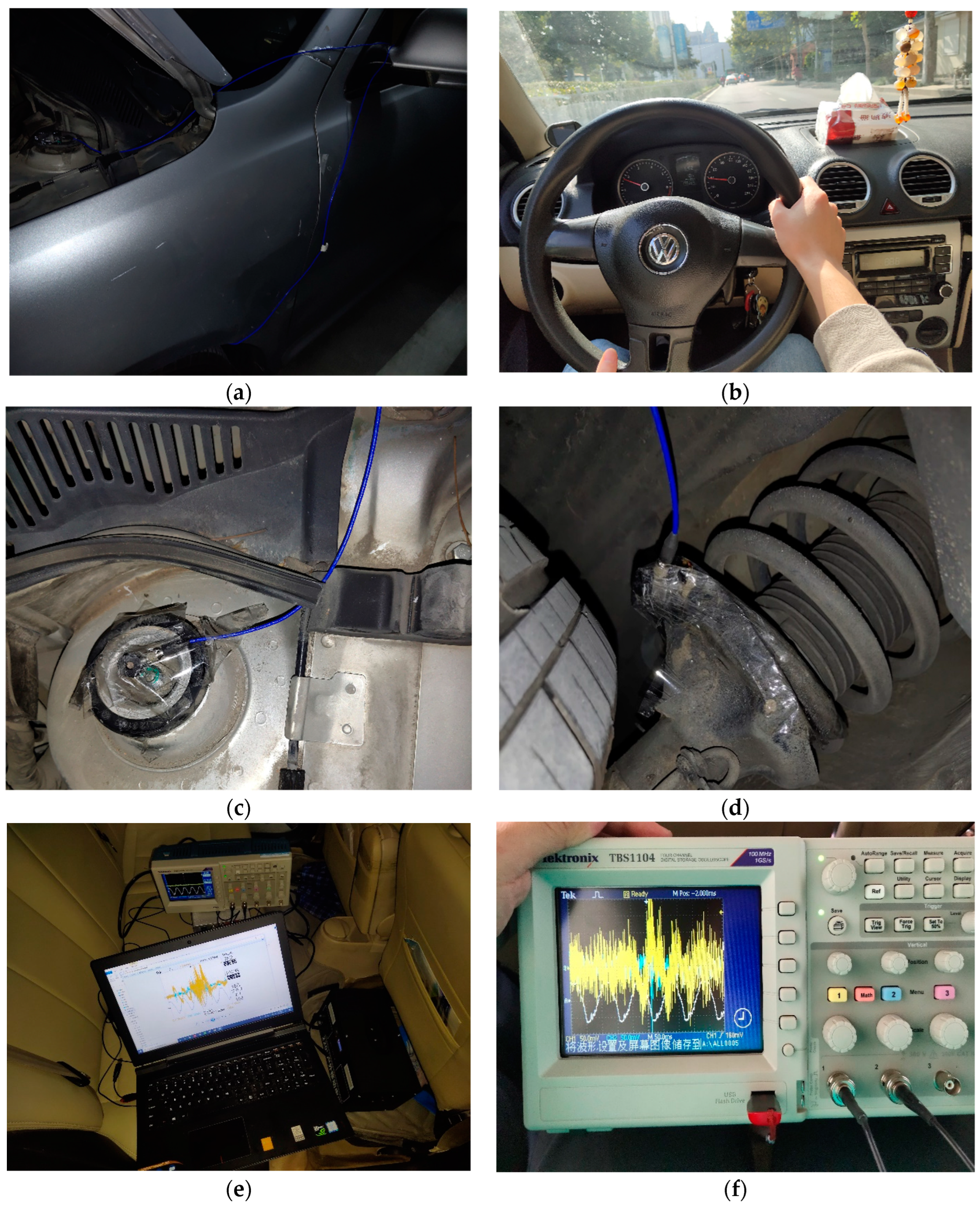



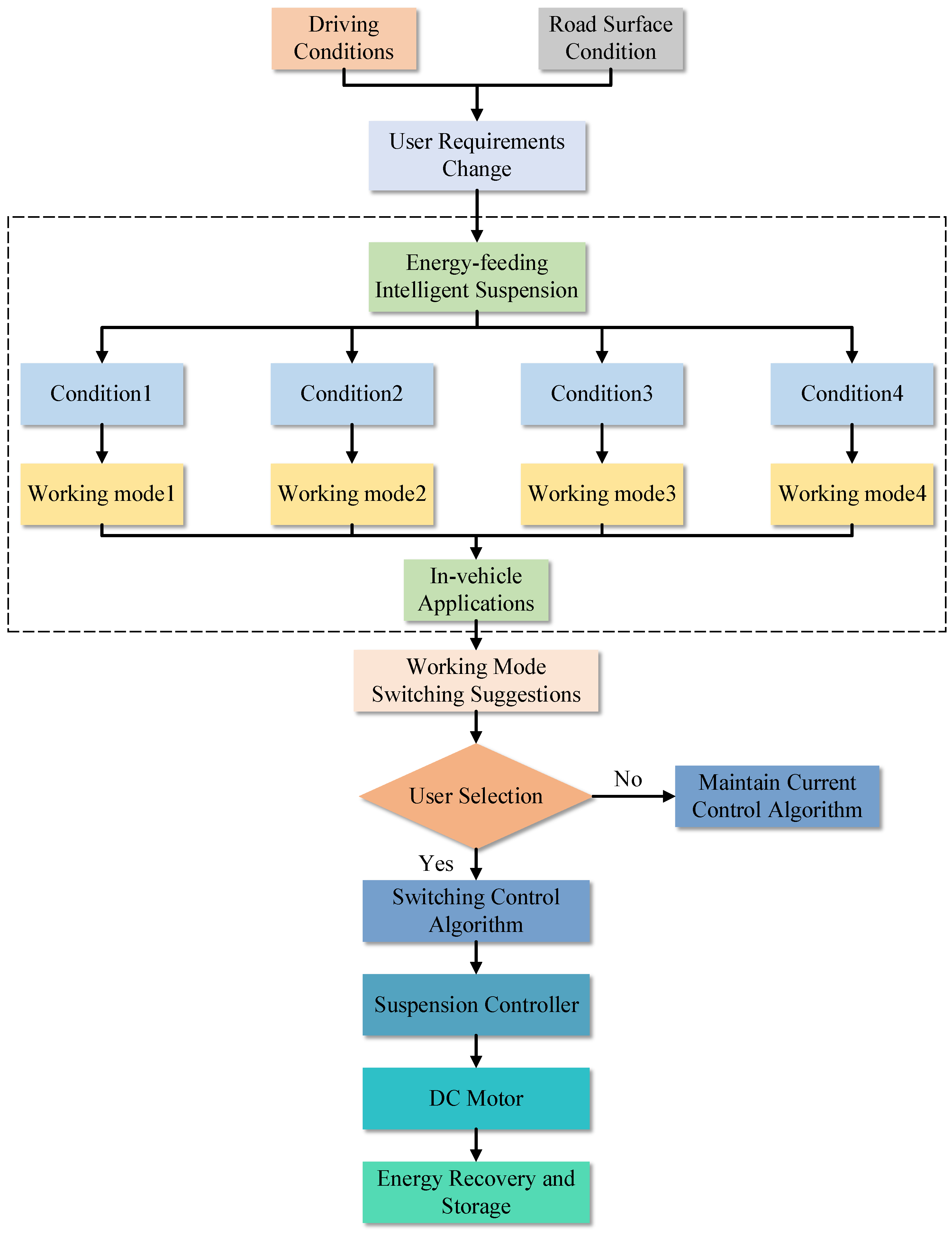
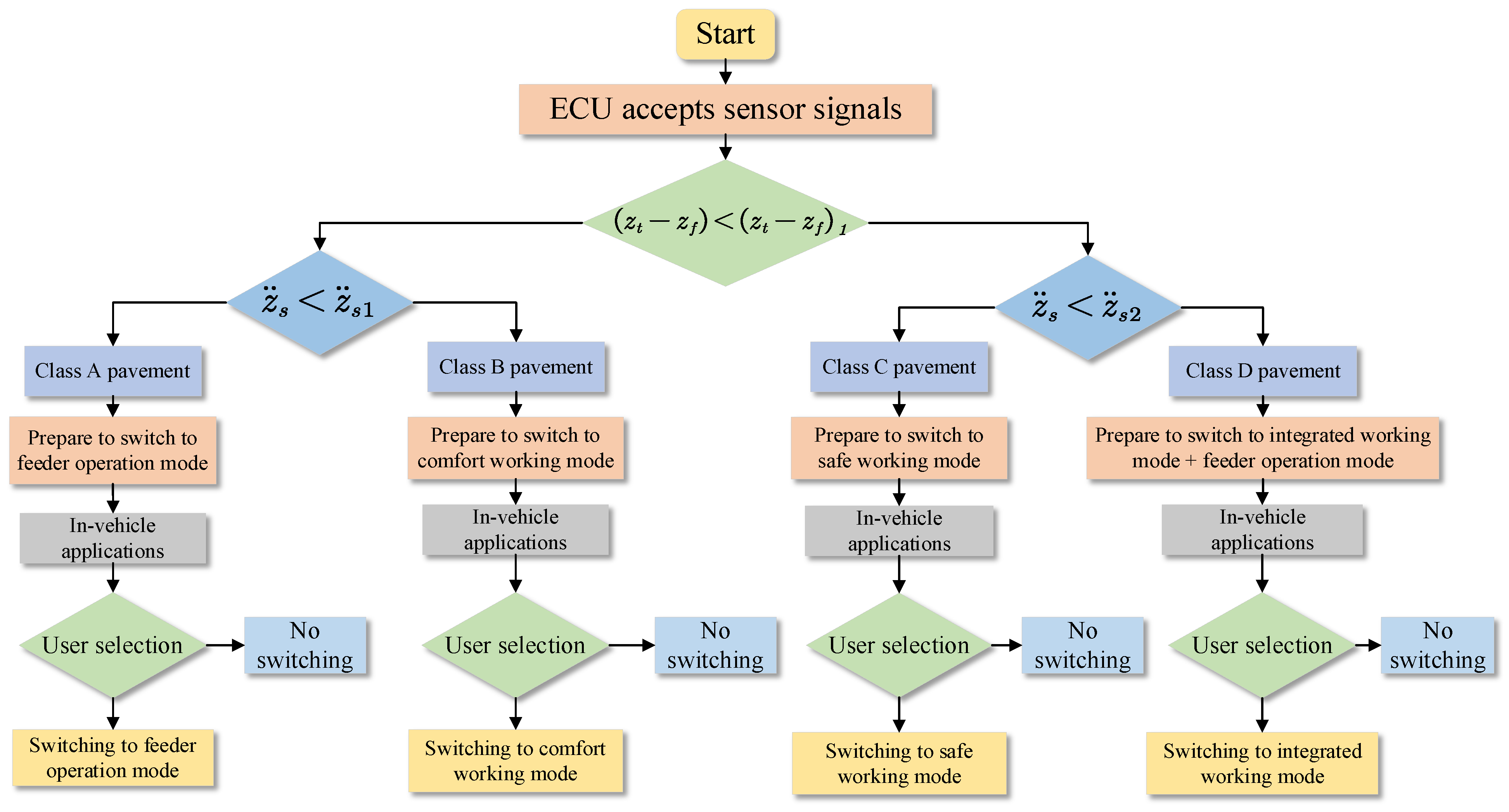
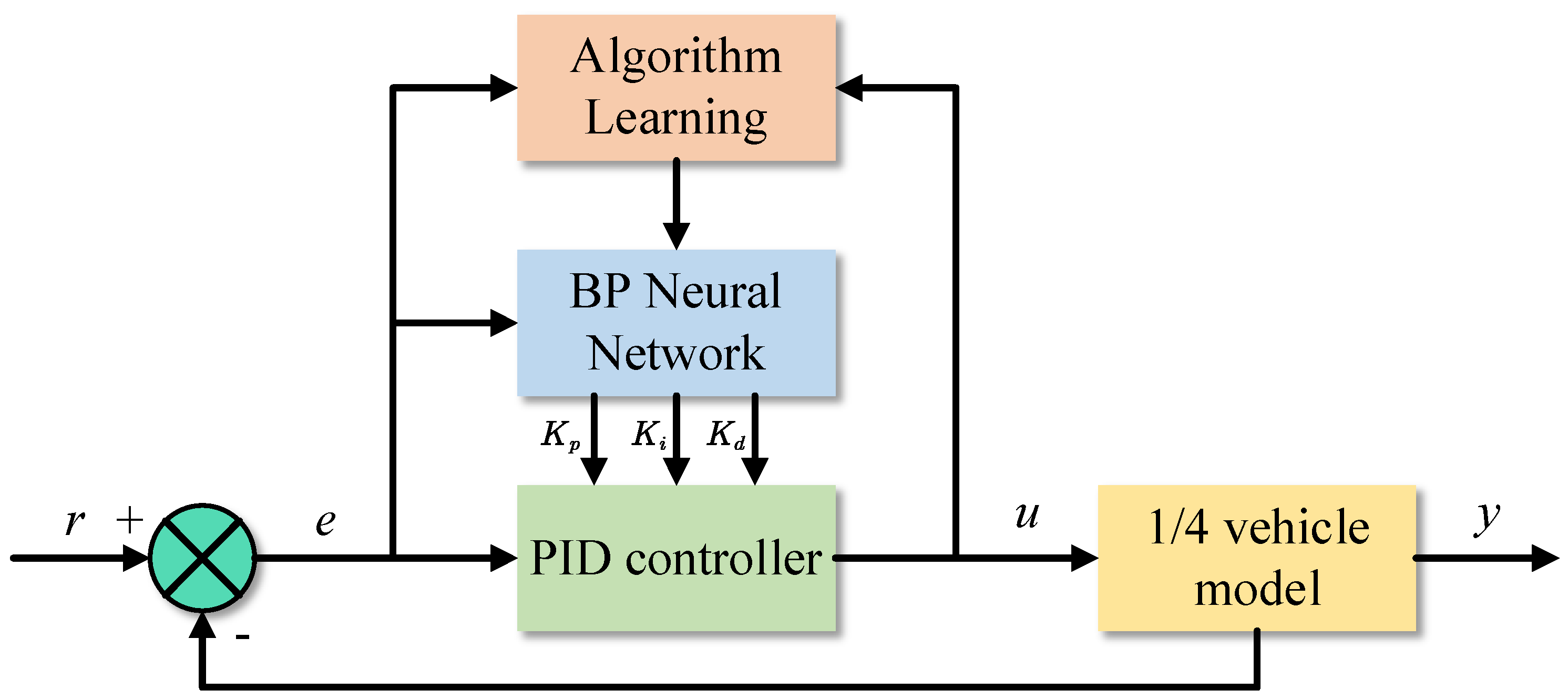
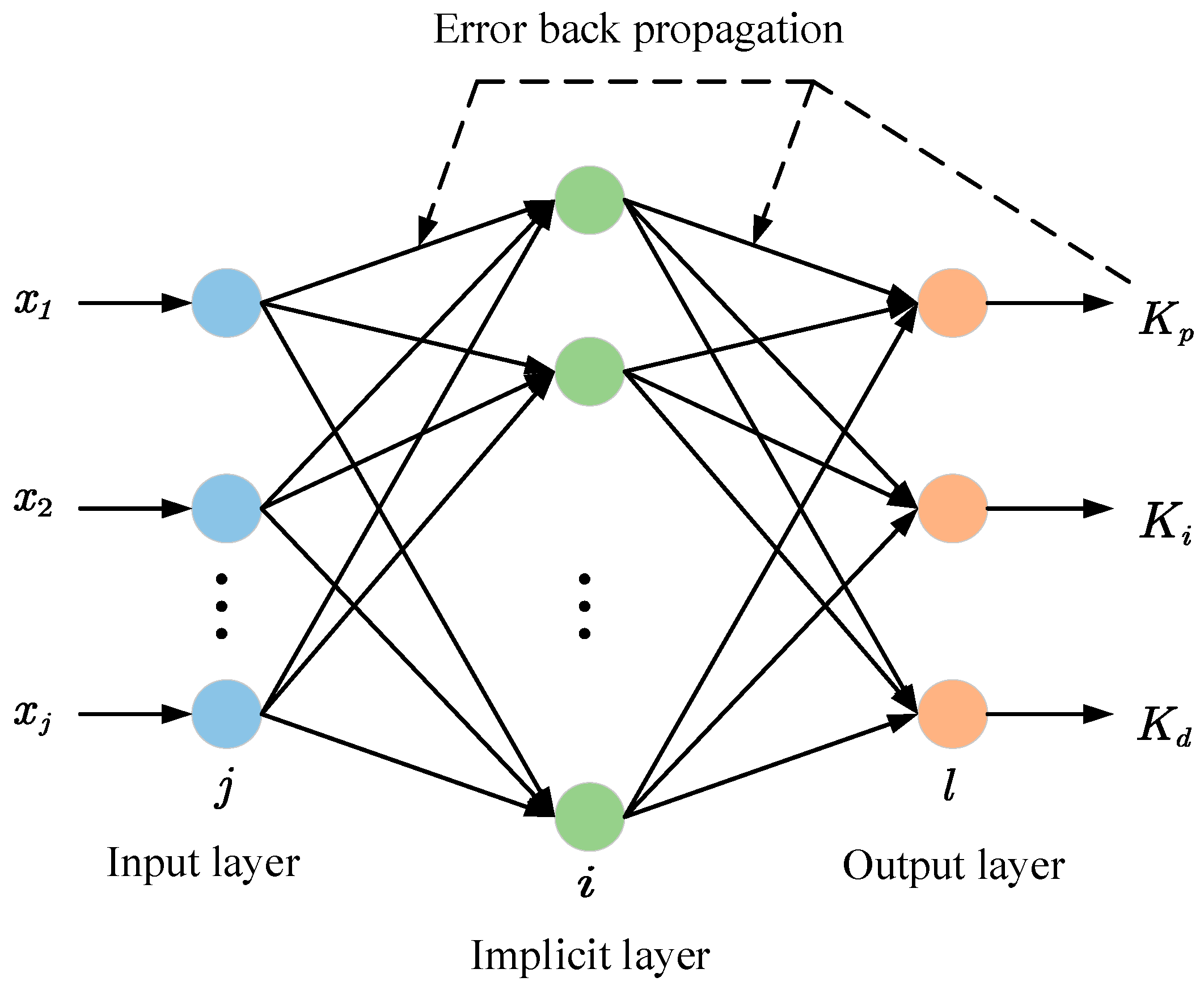
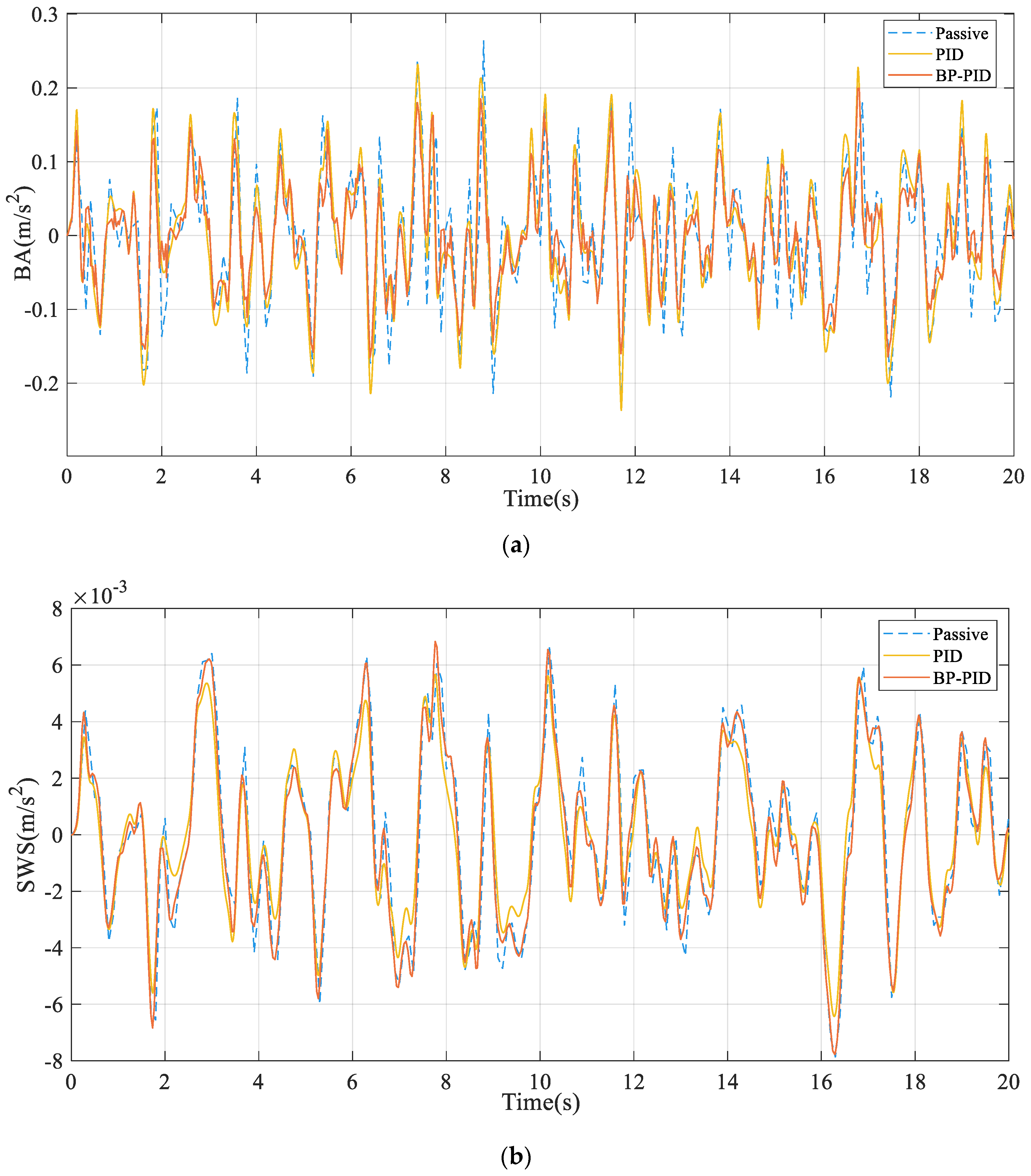




| Road Grade | |||
|---|---|---|---|
| Lower Limit | Geometric Mean | Upper Limits | |
| A | 8 | 16 | 32 |
| B | 32 | 64 | 128 |
| C | 128 | 256 | 512 |
| D | 512 | 1024 | 2048 |
| E | 2048 | 4096 | 8192 |
| F | 8192 | 16,384 | 32,768 |
| G | 32,768 | 65,536 | 131,072 |
| H | 131,072 | 262,144 | 524,288 |
| DTD | BA | Pavement Grade | Working Mode |
|---|---|---|---|
| A | Feedthrough Mode | ||
| B | Comfort Mode | ||
| C | Security Mode | ||
| D | Comprehensive Mode/ Feedthrough Mode |
| Parameter | Numerical Value |
|---|---|
| Body mass | |
| Tire mass | |
| Suspension spring stiffness | |
| Suspension damping factor | |
| Tire Stiffness | |
| Vehicle speed | |
| The lower limit cut-off frequency f0/Hz |
| Performance Indicators | Passive | PID | BP-PID |
|---|---|---|---|
| BA | 0.0927 | 0.0853 | 0.0688 |
| SWS | 3.1000 | 2.5000 | 2.9000 |
| DTD/(mm) | 1.9000 | 1.6000 | 1.4000 |
| Performance Indicators | Passive | LQR | GA-LQR |
|---|---|---|---|
| 1.6725 | 0.9696 | 1.0289 | |
| 24.8000 | 22.4000 | 19.4000 | |
| 2.8000 | 2.4000 | 2.2000 |
Disclaimer/Publisher’s Note: The statements, opinions and data contained in all publications are solely those of the individual author(s) and contributor(s) and not of MDPI and/or the editor(s). MDPI and/or the editor(s) disclaim responsibility for any injury to people or property resulting from any ideas, methods, instructions or products referred to in the content. |
© 2023 by the authors. Licensee MDPI, Basel, Switzerland. This article is an open access article distributed under the terms and conditions of the Creative Commons Attribution (CC BY) license (https://creativecommons.org/licenses/by/4.0/).
Share and Cite
Qu, Z.; Liu, J.; Li, Y.; Yang, F.; Liu, J. Study on Multi-Mode Switching Control of Intelligent Suspension under Full Road Section. Processes 2023, 11, 1776. https://doi.org/10.3390/pr11061776
Qu Z, Liu J, Li Y, Yang F, Liu J. Study on Multi-Mode Switching Control of Intelligent Suspension under Full Road Section. Processes. 2023; 11(6):1776. https://doi.org/10.3390/pr11061776
Chicago/Turabian StyleQu, Zhaole, Jianze Liu, Yang Li, Fazhan Yang, and Jiang Liu. 2023. "Study on Multi-Mode Switching Control of Intelligent Suspension under Full Road Section" Processes 11, no. 6: 1776. https://doi.org/10.3390/pr11061776
APA StyleQu, Z., Liu, J., Li, Y., Yang, F., & Liu, J. (2023). Study on Multi-Mode Switching Control of Intelligent Suspension under Full Road Section. Processes, 11(6), 1776. https://doi.org/10.3390/pr11061776







